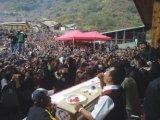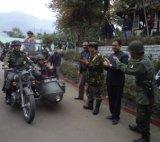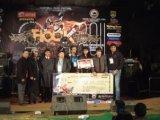Archives
12th Hornbill Festival of Nagaland
 Stressing on unity, the Governor said that the state has felt the need for unity cutting across all tribal affiliations and local factors. He said that everyone should unite because only through unity shall the people of Nagaland be able to give importance to the society through works of development to achieve progress and prosperity. He congratulated the Chief Minister for conceptualizing the Hornbill Festival which has brought together all sections of the people and which has given Nagaland its uniqueness rooted in the culture of Nagaland. He also lauded the State Tourism Department and hoped that the visitors would return home after the festival with fond memories.
Stressing on unity, the Governor said that the state has felt the need for unity cutting across all tribal affiliations and local factors. He said that everyone should unite because only through unity shall the people of Nagaland be able to give importance to the society through works of development to achieve progress and prosperity. He congratulated the Chief Minister for conceptualizing the Hornbill Festival which has brought together all sections of the people and which has given Nagaland its uniqueness rooted in the culture of Nagaland. He also lauded the State Tourism Department and hoped that the visitors would return home after the festival with fond memories.
The traditional blessings for the festival were given by the Tribal Guest, Yansathung Jami from Yanmhon Old Village Wokha
|
Chilli and Pork Eating Competition
The Naga King Chilly eating competition drew the maximum attraction at the Hornbill Festival where altogether 23 participants hailing from different Naga tribes contested. Namluai who consumed altogether 14.80% pieces and Keduhoto LLohe who consumed 14 solid pieces of Naga King Chilly were adjudged the second and third position holders respectively. On the other hand, the Israeli tourist Yakhim surprised the enthusiastic crowed by consuming altogether 11 red hot Naga King Chillies to bag the championship among the volunteering tourists. The other attraction was the Pork Fat Eating competition where altogether 15 persons including two women participated. In both the competitions, the winners walked home richer by `15,000, `10,000 and `5000 respectively. The prizes were later handed over to the winners by the Guest of Honour of the after session and Union Minister for DONER, Paban Singh Ghatowar who gave away the prizes to the winner of both the competitions. |
The Hornbill Festival of Nagaland is a cultural extravaganza to revive, protect and preserve the wealth and uniqueness of Naga heritage, while for the visitors to this event, it is a means for a comprehensive understanding of Naga people, their land and culture.
Over the years, this event has risen in stature and scale. It has now become a unique platform for the tourists to witness the cultural diversity not only of the Nagas but also of the seven other sister states of North East India in all it wonder and glory.
|
World War-II Peace Rally
There were 15 participants in the World War II Peace Rally, which started from Heritage Bungalow Kohima and went through all war sites in Kohima. The World War II Vintage Car Rally was flagged off by the DoNER Minister at the Heritage complex Kohima and the convoy led by the Commander in-Chief Neiphiu Rio, Nagaland Chief Minister, accompanied by Power Minister Doshehe and many other vehicles. The Commander in-Chief of the Rally, Rio said that war brings death and destruction whereas peace brings harmony and development. He therefore urged the people to spread the word of peace in Nagaland. The Chief Minister also gave away the prizes to the winners of the car rally. The best original vehicle 2011 was driven by Ashoke Lyndoh who was awarded `50000. Dr. B. Plain’s car bagged the best maintained vehicle and was awarded `30000 while Temjen Toy received best original/maintained vehicle and received `20000. Best team was bagged by Pedi Machieo who received `10000. Lanu Jamir received the Best original weaponry team and was awarded `10000. The tourism promotional team jointly went to Amung Konyak and Hatpa Wangao who were awarded `10000. Best Allied Forces was also jointly awarded to H.K. Khulu and Marina Khulu who received `10000. The disciplined team of the Peace Car rally went to Elvis Yanthan who received `10000. |
The week long Hornbill Festival under the theme ‘Unity in Culture’ was marked by a cultural exposition with cultural troupes from all the 16 tribes of Nagaland presenting their dances and songs.
|
Hornbill National Rock Contest 2011
INDIVIDUAL PRIZES Best Vocals - Girish & The Chronicles from Gangtok Sikkim Special categories Keyboards- Arcane Deception, New Delhi |
The unity dance was followed by individual dance performances by all tribes in the main arena after which visitors also joined in the dancing.

 Nyulazhi Pajor from the Pochury Naga tribe bagged the championship of the famous 2nd Naga King Chilly eating competition held at the Hornbill Festival by consuming 15 red hot chillies in a record time of 20 seconds on the 4th of December.
Nyulazhi Pajor from the Pochury Naga tribe bagged the championship of the famous 2nd Naga King Chilly eating competition held at the Hornbill Festival by consuming 15 red hot chillies in a record time of 20 seconds on the 4th of December.
 As part of the Hornbill Festival, a special event to commemorate the battle of Kohima World War II peace rally was held at the Heritage complex, Kohima on the 5th of December. Paban Singh Ghatowar, Minister of State (Independent Charge) for DoNER and Parliamentary Affairs was the Chief Guest of the function who also flagged off the peace rally.
As part of the Hornbill Festival, a special event to commemorate the battle of Kohima World War II peace rally was held at the Heritage complex, Kohima on the 5th of December. Paban Singh Ghatowar, Minister of State (Independent Charge) for DoNER and Parliamentary Affairs was the Chief Guest of the function who also flagged off the peace rally.
 Indigo Children from New Delhi won the coveted crown of the Hornbill National Rock Contest 2011 on the 7th of December night before a packed crowd at the Indira Gandhi Stadium, Kohima. Twenty four rock bands from all over the country took part in the four-day contest which was part of the seven-day Hornbill Festival of Nagaland. Indigo Children returned home with a cash prize of `5 lakhs which was sponsored by Airtel. The 2nd prize and 3rd prize were bagged by Grammy Winning Effort, New Delhi and Girish & The Chronicles from Gangtok Sikkim, who went home with `3.5 lakhs and `2.5 lakhs respectively.
Indigo Children from New Delhi won the coveted crown of the Hornbill National Rock Contest 2011 on the 7th of December night before a packed crowd at the Indira Gandhi Stadium, Kohima. Twenty four rock bands from all over the country took part in the four-day contest which was part of the seven-day Hornbill Festival of Nagaland. Indigo Children returned home with a cash prize of `5 lakhs which was sponsored by Airtel. The 2nd prize and 3rd prize were bagged by Grammy Winning Effort, New Delhi and Girish & The Chronicles from Gangtok Sikkim, who went home with `3.5 lakhs and `2.5 lakhs respectively.